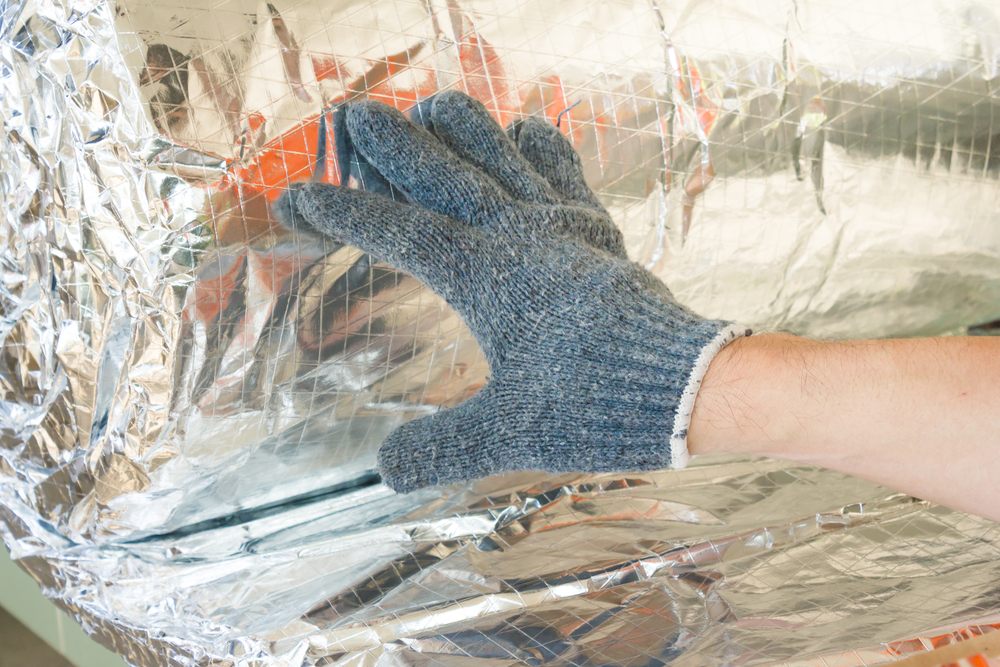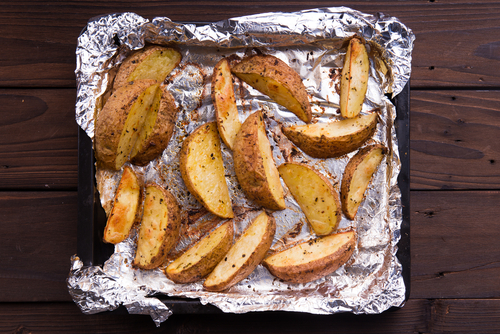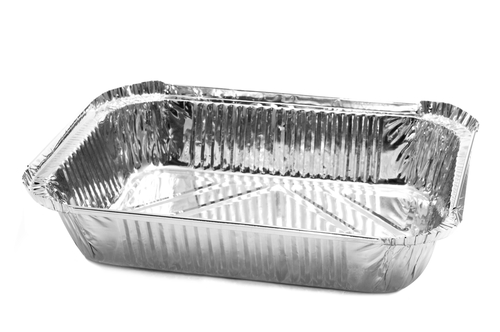Many hikers and preppers, including myself, carry aluminum foil in their survival bags.
Over the years, we’ve learned how useful this item can become in the wilderness and how it can save you a lot of headaches. I’ve discovered a lot of ways to use aluminum foil while exploring the great outdoors, and every time I’m using it, I’m amazed how versatile this item really is.
Every household in the United States has a roll or two of heavy-duty aluminum foil hidden in their kitchen drawers. It is one of the items that can be used in an emergency situation, regardless if you are in the city or in the wilderness. The only limitation when it comes to using aluminum foil during a crisis is not having enough imagination or the proper mindset to repurpose it.
As you will see below, I found many uses for it, and I always try to figure out ways to use it in almost any activity.
My top wilderness uses for aluminum foil
1. Cooking cleanup is much easier with aluminum foil. If time is of the essence and if you have a tight schedule to follow when bugging out, you can use it to make cleaning much easier and faster. You can line a cast iron pan with foil to avoid sticky food residue (or keep it to a minimum).
I did this often times during the evening when I didn’t have enough time nor water to clean my cooking pots properly. Not to mention that if you use it to line your cooking pots, you will not have to worry about keeping food residue in your vicinity and attract unwanted animals during the night time.
2. You can improvise a frying pan. All you need to do to make a useful frying pan is a sturdy branch from which you can improvise a fork and then wrap the foil around it. I’ve used this method to fry fish but also mushrooms, and it works like a charm!
3. Years ago, I learned from my father how to improvise all sorts of cooking accessories from aluminum foil. You can make a serving plate, a cup, a pair of thongs for grilling, and pretty much anything you can think of. It all depends on your cooking needs and the skills you have.
4. For cooking food in the wilderness, you can use aluminum foil and improvise a solar oven. If you happen to have a cardboard box in reach, the job is much easier than you think. If not, you can make a cage from sticks and thin branches using your paracord and then line it with the aluminum foil.
5. Aluminum foil can also help you prolong a campfire and use its heat to warm your shelter. You can use the foil to block the wind and protect the flames by improvising a small wall from branches, lined with the foil.
6. Collecting rainwater should be an obvious use at this point. You can improvise a funnel to divert rainwater into your container, or you can build from the foil a large pot and place it in a spot with abundant rainfall.
7. You can create a lantern using your lamp and some aluminum foil. Wrap a piece of foil around one side of your lamp, and you can focus the beam of light in the direction you need.
Catch A Glimpse of Green Beret Outdoor Survival Ingenuity
8. Due to its reflective nature, aluminum foil is ideal for signaling. You can use it just as a signaling mirror to signal a rescue plane or a passing vehicle in the distance. Also, you can tie multiple strips of aluminum foil to branches in order to make a signaling flag. Just make sure you are a good tree climber.
9. Aluminum foil can help you find your way back to camp. Since people will get lost easily in the wilderness due to the lack of orientation skills or by getting easily distracted, they can find their way back to camp by using the foil. Make string from it and tie them to branches to mark your path back to camp. This is also useful during night time since the foil will reflect light from your flashlight and even the moonlight.
10. Use it to waterproof your bag or critical items. Crossing a river will make things get wet faster than you would expect. To save the day, put all your sensitive items such as matches, cellphones, socks, and anything you want to keep dry in an improvised aluminum bag. For added security and peace of mind, you can wrap all the items individually before putting them together in the improvised bag.
11. This one is probably my favorite, and I’ve learned if from more experienced campers. I often go camping carrying a survival hammock, and I’ve learned to make drip rings from aluminum foil. It keeps water runoff away from your sleeping area, and you won’t wake up in a puddle.
12. Aluminum foil is very useful for warming your sleeping bag during colder nights. I’ve learned this one from attending a survival course in the UK. Besides teaching us how to make a hotbed, the guide also taught us how to warm our sleeping bags using stones and aluminum foil. You will need to heat some stone in the campfire coals, wrap them in foil and place them by your feet. This will help you keep warm during cold nights, providing an extra level of comfort.
13. Use it to keep your sleeping bag dry and warm. This is recommended if you like sleeping on the ground. The foil will prevent moisture from reaching your sleeping bag, and at the same time, it will reflect back the heat emanated by your body.
14. Make fishing lures. By using a pocket knife, you can create feathered edges for your fish hooks. The shiny edges will flutter in the water and will convince fish such as bass to bite on your lure.
15. When you forage for food and you find sticky and/or mushy goodies, you can avoid ruining your socks and improvise a container from aluminum foil. You can carry everything in it, and you will not stain your clothes or bag. Not to mention that you can easily wash the container and use it for other purposes later on.
16. Protect your berry shrubs with the foil. If you have to forage for food while being stranded in the wilderness, chances are you could find some berries. Seeing that in nature, there is a great competition for these wild berries, you will need to protect the bushes from birds and other critters. If you tie strips of foil to the branches, you will keep animals at bay, and there will still be some berries left when you return the next day.
17. Make a cache. Although not the best tactic for making a cache, it can do a pretty good job when nothing else is available. All you need to do is dig a hole, line the bottom with rocks, wrap your items in aluminum foil, and put them in the hole. Before covering your supplies with dirt, make sure you mark the spot or acknowledge the available landmarks. This will save you time from digging multiple holes just to find your supplies.
18. Firestarter aid. A lot of preppers and survivalists are using petroleum jelly fire starters, but few of them know that the following trick that can improve the duration of the flame. If you place the fire starters on a piece of aluminum foil, you will prevent the jelly from melting into the ground below, and the flame will last longer. This is a neat trick if you need to start a flame in cold or wet environments.
19. It can be used to make small repairs. If your water bottle gets pierced or your water canteen gets cracked, you can use the foil in conjunction with pine sap to seal the container. In times of need, it can also use it to enhance the signal of devices with traditional antennas if you wrap a ball of foil around the end of the antenna. Even more, you can fix the loose springs from your devices and hold batteries in place by folding a small piece of foil and placing it between the battery and the loose spring.
20. It’s a good overall insulator. I’ve used it to insulate shelters made from natural materials, I’ve used it to insulate the windows from our home when testing our survival drill during the winter. I’ve used it for my camping tent and so on. This becomes a reliable insulator when facing harsh weather regardless if you’re in the wilderness or in the city.
Concluding
As you saw in this article, aluminum foil is an inexpensive item that can become a multi-use survival tool in case needed. I’ve said it before, and I will say it again: In a survival situation, improvisation is the mother of necessity. The versatility of aluminum foil makes it an ideal candidate for your survival bag, and you should really consider buying a roll or two for emergency situations.









































































60 years ago when I was in the scouts, we would put a ground beef patty, some potato’s, and onions in some aluminium foil wrap it up good and bake it for about a hr and a half over a camp fire. it either was great or we were hungry, kids in the mountains. we ate it out of the foil and had almost nothing left to clean up.
you left out making a hat so you can’t be located and yer thoughts read……
A useful property of aluminum foil is that it has low emissivity in the infrared spectrum. Things wrapped in foil keep heat and cold in because they do not efficiently radiate, or absorb, infrared (heat). People think white vs. black makes a difference, but they look the same in an infrared camera. Most things have high emissivity, aside from shiny metal surfaces. Anodized aluminum, colored or not, has high emissivity, like the heat sinks in electronic devices.
Aluminum is a good conductor of heat, but foil is so thin, it doesn’t carry much heat.
There are 3 and only 3 ways heat is transferred: conduction, convection, and radiation.
The fumes when in direct contact with fire are toxic and considered a carcinogen.
Can anyone explain number 2 to me? I do not understand what he is trying to say at all!
Cut a fork from a branch. Wrap it in foil with flat area between the fork Y and then place there, on the flat foiled area, anything needed for frying on the open fire. The foil will protect the branch from burning for longer than required to fry anything. Hope it helps :).
I think Aluminium is great with it’s many uses but aluminum is not at all healthy for the body, let alone the brain. I assume it this point if you have to bug out or otherwise due to dire situations…it would not matter!
That’s right. Aluminum is very toxic under some circumstances. It is the only element (of the common ones) that does NOT HAVE ANY function in the human body or in the ecosystem in its pure metallic form. All aluminum is bonded in compounds and requires tremendous amount of electricity to be retrieved in pure metallic form. It readily reacts with acids and if your food is somewhat acidic (any many are) than some of the aluminum gets in your system playing harmful havoc in many different ways, particularly blocking vitamin D absorption that plays a major role in many essential metabolic processes. Aluminum toxicity in today’s world is very common and is suspected to be the hidden but largely not recognized cause of cancers and many immune system disorders. Even using food wrapping from aluminum can be very toxic in a longer time frame. Wrap a macdonald burger with a lot of ketchup (mild acid) and the next day you will see small holes in the aluminum wrapping where the acid dissolved the metal that penetrated into the food and into your system if you ate it.
Avoid using aluminum with food processing as much as possible and if necessary only in an emergency situation, not as a rule.
Thanks for the info, actually the reminder! I am now going to quit heating my meals on top of aluminum foil on a pan in my toaster oven! Made life very simple and easy, but now I realize perhaps at a hidden cost to my health!
I found Parchment paper to be a great help instead of aluminum foil, in many cases in the kitchen
If you are camping in a national forest or park, you’ll have to carry all your used aluminum foil and other trash out with you. You should do that regardless of where you camp. If you are in a SHTF situation, you’ll have to bury it in an out of the way spot. If you think you are or might be followed you can leave nothing behind to show you’ve been there. Aluminum foil is very versatile and can be used for many things. It’s good to have some ‘heavy duty’ foil on hand. It can, also, be reused, depending on what you use it for.
Elaine. #2 is using the forked area of a branch to spread the foil across, anchoring it around the edges. Use the flat surface to cook like a pan.
No, aluminum is NOT an insulator. It can reflect heat, but it does not insulate.
And cooking with aluminum is convenient, but aluminum isn’t good for the body. This is why it’s been said that the increase in the use of aluminum for pots and other cooking uses has a lot to do with the increase in Alzheimer’s.
Great ideas, however , 3. Years ago, I learned from my father how to improvise all sorts of cooking accessories from aluminum foil. You can make a serving plate, a cup, a pair of thongs for grilling, and pretty much anything you can think of.
In the contexts, I think you mean TONGS.
Thongs, in my world could either be protection for the feet at a beach or sexy under wear.
Funny, my mind read tongs. I had to go back and see the typo.
Make sure you buy the heavy duty foil, not the regular stuff.
This a great reminder of all things which can be useful for SHTF. There are so many ways we use foil around the house why not outdoors. Thanks for the reminder.